Solar eclipse of August 21, 2017: Difference between revisions
Extended confirmed users, IP block exemptions 3,535 edits m →Visibility: ce |
No edit summary |
||
| Line 207: | Line 207: | ||
* [http://www.nationaleclipse.com 2017 eclipse site] with eclipse overview, maps, cities, events, animations, safety, gear, history, and calendar. |
* [http://www.nationaleclipse.com 2017 eclipse site] with eclipse overview, maps, cities, events, animations, safety, gear, history, and calendar. |
||
* [https://www.eia.gov/todayinenergy/images/2017.08.07/mainlarge.png Solar power impact], diagram from EIA <!--from <ref name=eia2017-08-07> https://www.eia.gov/todayinenergy/detail.php?id=32372 --> |
* [https://www.eia.gov/todayinenergy/images/2017.08.07/mainlarge.png Solar power impact], diagram from EIA <!--from <ref name=eia2017-08-07> https://www.eia.gov/todayinenergy/detail.php?id=32372 --> |
||
* [http://blog.stephenwolfram.com/2017/08/when-exactly-will-the-eclipse-happen-a-multimillenium-tale-of-computation/ When Exactly Will the Eclipse Happen? A Multimillenium Tale of Computation] |
|||
{{Solar eclipses}} |
{{Solar eclipses}} |
||
Revision as of 15:57, 17 August 2017
| Solar eclipse of August 21, 2017 | |
|---|---|
UTC) | |
| (P1) Partial begin | 15:46:48 |
| (U1) Total begin | 16:48:32 |
| Greatest eclipse | 18:26:40 |
| (U4) Total end | 20:01:35 |
| (P4) Partial end | 21:04:19 |
| References | |
| Saros | 145 (22 of 77) |
| Catalog # (SE5000) | 9546 |
On Monday, August 21, 2017, a
A
The last time a total solar eclipse was visible across the entire contiguous United States was during the
There are expected to be logistical issues with the influx of visitors, especially for smaller communities.[4][5] There have also been issues with counterfeit eclipse glasses being sold.[6][7][8]
Future total solar eclipses will cross the United States in April 2024 (12 states) and August 2045 (10 states), and annular solar eclipses — meaning the apparent size of the Moon is smaller than that of the Sun — will occur in October 2023 (9 states) and June 2048 (9 states).
Visibility

The total eclipse will have a
The longest duration of totality will be 2 minutes 41.6 seconds at about 37°35′0″N 89°7′0″W / 37.58333°N 89.11667°W in Giant City State Park, just south of Carbondale, Illinois, and the greatest extent (width) will be at 36°58′0″N 87°40′18″W / 36.96667°N 87.67167°W near the village of Cerulean, Kentucky, located in between Hopkinsville and Princeton.[11] This will be the first total solar eclipse visible from the Southeastern United States since the solar eclipse of March 7, 1970, which was only visible from Florida.
A partial solar eclipse will be seen from the much broader path of the
Related eclipses over the United States

This eclipse will be the first total solar eclipse visible from the United States since the solar eclipse of July 11, 1991[12] (which was seen only from part of Hawaii),[13] and the first visible from the contiguous United States since 1979.[14]
The path of totality of the
Some American scientists and interested amateurs seeking to experience a total eclipse participated in a four-day Atlantic Ocean cruise to view the solar eclipse of July 10, 1972 as it passed near Nova Scotia. Organizers of the cruise advertised in astronomical journals and in planetarium announcements emphasizing the lack of future total eclipses observable in U.S. until this 2017 event.[17]
The August 2017 eclipse will be the first with a path of totality crossing the Pacific and Atlantic coasts of the U.S. since 1918. Also, its path of totality makes landfall exclusively within the United States, making it the first such eclipse since the country's independence in 1776. (The path of totality of the eclipse of June 13, 1257, was the last to make landfall exclusively on lands currently part of the United States.[18])
The path of this eclipse crosses the path of the upcoming total solar eclipse of April 8, 2024, with the intersection of the two paths being in southern Illinois in Makanda Township at Cedar Lake just south of Carbondale. A small land area, including the cities of Makanda, Carbondale, Cape Girardeau, Missouri, and Paducah, Kentucky, will thus experience two total solar eclipses within a span of less than seven years.
The solar eclipse of August 12, 2045 will have a very similar path of totality over the U.S., about 400 km (250 mi) to the southwest, also crossing the Pacific and Atlantic coasts of the country; however, duration of totality will last over twice as long.[19]
An eclipse of comparable length (up to 3 minutes, 8 seconds, with the longest eclipse being 6 minutes and 54 seconds) occurred over the contiguous United States on March 7, 1970 along the southern portions of the Eastern Seaboard, from Florida to Virginia.[20]
Total eclipse viewing events

Oregon
- Corvallis, Oregon – The Corvallis campus of Oregon State University will host OSU150 Space Grant Festival: A Total Eclipse Experience a weekend-long celebration of the eclipse. A watch party will also be hosted on campus the day of the eclipse.
- Keizer, Oregon – The Salem-Keizer Volcanoes a Class A baseball team will play a morning game that will feature the first ever "eclipse delay" in baseball history.[21]
- Madras, Oregon – The city will sponsor a four-day Solarfest at two locations.[22][23]
- Prineville, Oregon – Symbiosis Gathering will be hosting a global eclipse gathering.[24] Dubbed Oregon Eclipse.[25]
- Oregon State Fairgrounds.[26]
Idaho

- Craters of the Moon – The National Monument and Preserve will host NASA presentations, evening star parties hosted by the Idaho Falls Astronomical Society, high altitude balloon launches by the USC Astronautical Engineering department and NASA, and presentations by the New Mexico Chapter of the Charlie Bates Solar Astronomy Project.[27]
- Idaho Falls, Idaho – Free entertainment and educational seminars and an eclipse-watching event at the Museum of Idaho (an official NASA viewing site) and elsewhere, and a free eclipse-watching event at Melaleuca Field.[28][29]
- Brigham Young University Idaho will offer a series of eclipse related educational events.[30]
- Weiser, Idaho – The city will sponsor a five-day festival prior to the eclipse.[31]
Wyoming
- Casper, Wyoming – The Astronomical League, an alliance of amateur astronomy clubs, will hold its annual Astrocon conference,[32] and there will be other public events, called Wyoming Eclipse Festival 2017.[33]
Nebraska
- Alliance, Nebraska – Entertainment and educational seminars will be offered.[34]
- Auburn, Nebraska – Nemaha County Hospital will host an eclipse viewing event, including sharing safety tips from Lifetime Vision Center. The event is sponsored by Auburn State Theater.[35]
- Grand Island, Nebraska – Stuhr Museum will host an eclipse viewing event, including the launch of a NASA eclipse observing balloon.[36]
- Homestead National Monument of America – Events with NASA Saturday, Sunday and the day of the eclipse homestead events page[37]
Missouri
- Kansas City, Missouri – A 5-mile bicycle ride from downtown KCMO (where totality will only last about 30 seconds) to Macken Park in North Kansas City (where totality will last 1 minute 13 seconds) has been organized by KC Pedal Party Club, a local Meetup group.[38]
- Lathrop, Missouri – The city will celebrate its 150th anniversary with an eclipse festival.[39]
- Parkville, Missouri – TotalEclipseofthePark – August 20 educational program featuring NASA Glenn Research Center Hall of Famer Lynn Bondurant, '61, and August 21 watch party organized by Park University.[40]
- St. Clair, Missouri – An event organized by the St. Clair City Chamber of Commerce.[41]
- St. Joseph, Missouri – An event organized by Front Page Science will be held at Rosecrans Memorial Airport.[42]
Illinois
- Eclipse Express, from Chicago to Carbondale.[44]
- Carterville, Illinois – A three-day rock festival called Moonstock will be headlined by Ozzy Osbourne, who will perform during the eclipse.[45]
- University of Illinois Astronomy Department.[46]
Kansas
- Atchison, Kansas — Benedictine College will host thousands in its football stadium. There will be students from schools from Kansas, Missouri, Nebraska and Oklahoma attending, plus numerous other guests who will hear from, amongst others, astronomers from the Vatican Observatory.[47]
Kentucky
- Bowling Green, Kentucky — Western Kentucky University will host thousands of K-12 students in its football stadium.[48]
- Hopkinsville, Kentucky – A four-day eclipse festival will be held at Jefferson Davis State Historic Site.[49]
Tennessee
- Clarksville, Tennessee – Austin Peay State University will present several educational events, including an appearance by astronaut Rhea Seddon.[50]
- Tennessee Technological University will be hosting a solar eclipse viewing party at Tucker Stadium, which is open to the public. The city of Cookeville will be hosting special events Saturday-Monday.[51]
- Nashville, Tennessee – The largest city in the path of totality is offering many special events, including the Music City Eclipse Science & Technology Festival at the Adventure Science Center.[52] The Italian Lights Festival is hosting the largest Eclipse Viewing Party in Nashville, a free NASA-Certified Eclipse Event held at the Bicentennial Mall.[53] Two astrophysicists from NASA's Jet Propulsion Laboratory will emcee the countdown.[54]
North Carolina
- Bryson City, North Carolina – Planetarium shows will be offered, as well as rides on the Great Smoky Mountains Railroad to an eclipse location.[55]
- Rosman, North Carolina – Pisgah Astronomical Research Institute (PARI) will be hosting a viewing event. The event at PARI has garnered international attention and the visitors will include amateur astronomers.
Georgia
- Blairsville, Georgia, Get off the Grid Festival[56]
South Carolina
- Columbia, South Carolina – The South Carolina State Museum will host four days of educational events, including an appearance by Apollo 16 astronaut Charles Duke.[57]
- Greenville, South Carolina – Viewing at Furman University.[58] Events include streaming coverage from NASA, educational activities, and live music.[59]
Viewing from outside the United States

Canada
A partial eclipse will be visible across the width of Canada, ranging from 89% in Victoria, British Columbia to 11% in Resolute, Nunavut.[60]
Central America, Mexico, Caribbean islands
A partial eclipse will be visible from Central America, Mexico, and the Caribbean islands.
Europe
In northwestern Europe, the eclipse will only be visible partially, in the evening or at sunset. Only those in Iceland, Ireland, Scotland and the Portuguese Azores archipelago will see the eclipse from beginning to end; in the rest of the UK, Norway, the Netherlands, Belgium, France, Spain and Portugal, sunset will occur before the end of the eclipse. In Germany, the beginning of the eclipse will be potentially visible just at sunset only in the extreme northwest of the country. In all regions east of the orange line in the map, the eclipse will be invisible.[61]
Russia
A partial eclipse will be visible only in Chukchi Peninsula (with about ~40%).
Online viewing events
- NASA – Live video streams of the event will be available on NASA's website.[62]
- Exploratorium – A live-stream of the event can be seen in-person at the Exploratorium museum in San Francisco, California or online on their website.[63]
Further images
-
August 21, 2017 total solar eclipse
-
Animation
-
Umbra (black oval), penumbra (concentric shaded ovals), and path of totality (red).
-
High-resolution map of the path in the United States.
-
This video features several visualizations of the event.
Planning
Counterfeit eclipse glasses have become a public health issue; deficient solar eclipse filters can quickly cause irreparable eye damage inasmuch as the retina has no pain receptors. In particular, it's not enough that the glasses have a logo and the ISO number 12312-2; customers must be reasonably confident that the glasses have come from a reputable manufacturer and/or authorized dealer. A person should not be able to see much through a safe solar filter except for the Sun itself, sunlight reflected off shiny metal, the hot filament of unfrosted incandescent light bulbs, bright halogen light bulbs, bright LED flashlights, and an arc-welder's torch; a welder's helmet can be used for safe viewing provided it has a filter of 12 or higher. [6][7][8]The American Astronomical Society states that not only must effective glasses dim the Sun to a comfortable level, but they must do so across the whole electromagnetic spectrum, for example also filtering most ultraviolet and infrared light.[6]
Logistically, the demand for
Impact on solar power
The eclipse will cause a reduction of solar power where the shadow reaches solar panels. The North American Electric Reliability Corporation measures impacts of this event,[69] and predicts
minor impacts.
Commemorative stamp
On June 20, 2017,[75] the United States Postal Service released the first application of thermochromic ink to postage stamps in its Total Eclipse of the Sun Forever stamp[76] to commemorate the solar eclipse of August 21, 2017. When pressed with a finger, body heat turns the black circle in the center of the stamp into an image of the full moon. The stamp image is a photo of a total solar eclipse seen in Jalu, Libya, on March 29, 2006. The photo was taken by retired NASA astrophysicist Fred Espenak.[76]
Related eclipses
A partial lunar eclipse took place on August 7, 2017, in the same eclipse season. It was visible over eastern Europe, Africa, Asia, and Australia.
Solar eclipses 2015–2018
This eclipse is a member of a semester series. An eclipse in a semester series of solar eclipses repeats approximately every 177 days and 4 hours (a semester) at alternating nodes of the Moon's orbit.[77]
| Descending node | Ascending node | |||||
|---|---|---|---|---|---|---|
| Saros | Map | Gamma | Saros | Map | Gamma | |
120 Longyearbyen, Svalbard |
2015 March 20 Total |
0.94536 | 125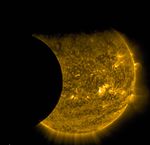 Solar Dynamics Observatory |
2015 September 13  Partial (south) |
−1.10039 | |
130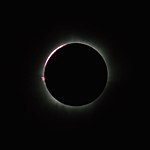 Balikpapan, Indonesia |
2016 March 9 Total |
0.26092 | 135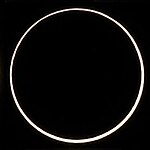 L'Étang-Salé, Réunion |
2016 September 1 Annular |
−0.33301 | |
140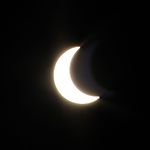 Partial from Buenos Aires |
2017 February 26 Annular |
−0.45780 | 145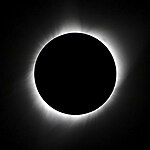 Casper, Wyoming |
2017 August 21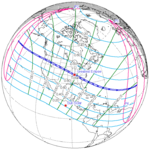 Total |
0.43671 | |
150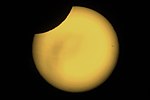 Partial from Olivos, Buenos Aires |
2018 February 15 Partial (south) |
−1.21163 | 155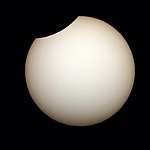 Partial from Huittinen, Finland |
2018 August 11 Partial (north) |
1.14758 | |
Partial solar eclipses on July 13, 2018, and January 6, 2019, occur during the next semester series.
Saros series 145
This solar eclipse is a part of Saros cycle 145, repeating every 18 years, 11 days, 8 hours, containing 77 events. The series started with a partial solar eclipse on January 4, 1639, and reached a first annular eclipse on June 6, 1891. It was a hybrid event on June 17, 1909, and total eclipses from June 29, 1927, through September 9, 2648. The series ends at member 77 as a partial eclipse on April 17, 3009. The longest eclipse will occur on June 25, 2522, with a maximum duration of totality of 7 minutes, 12 seconds. All eclipses in this series occurs at the Moon's ascending node.
| Series members 10–32 occur between 1801 and 2359 | ||
|---|---|---|
| 10 | 11 | 12 |
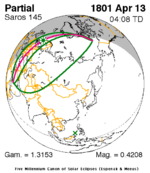 April 13, 1801 |
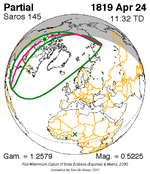 April 24, 1819 |
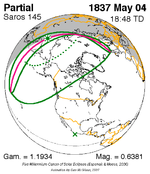 May 4, 1837 |
| 13 | 14 | 15 |
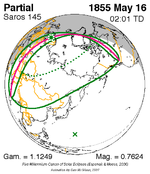 May 16, 1855 |
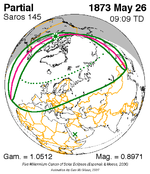 May 26, 1873 |
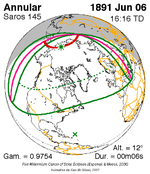 June 6, 1891 |
| 16 | 17 | 18 |
 June 17, 1909 |
 June 29, 1927 |
 July 9, 1945 |
| 19 | 20 | 21 |
 July 20, 1963 |
 July 31, 1981 |
 August 11, 1999 |
| 22 | 23 | 24 |
 August 21, 2017 |
 September 2, 2035 |
 September 12, 2053 |
| 25 | 26 | 27 |
 September 23, 2071 |
 October 4, 2089 |
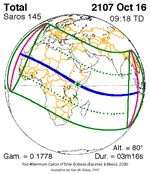 October 16, 2107 |
| 28 | 29 | 30 |
 October 26, 2125 |
 November 7, 2143 |
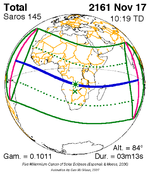 November 17, 2161 |
| 31 | 32 | 33 |
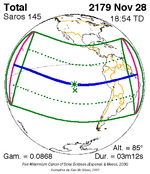 November 28, 2179 |
 December 9, 2197 |
 December 21, 2215 |
| 34 | 35 | 36 |
 December 31, 2233 |
 January 12, 2252 |
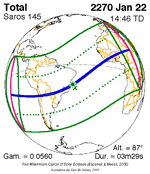 January 22, 2270 |
| 37 | 38 | 39 |
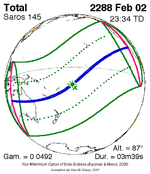 February 2, 2288 |
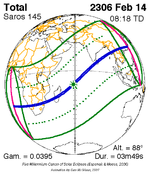 February 14, 2306 |
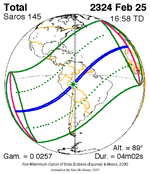 February 25, 2324 |
| 40 | ||
 March 8, 2342 | ||
Metonic series
The metonic series repeats eclipses every 19 years (6939.69 days), lasting about 5 cycles. Eclipses occur in nearly the same calendar date. In addition, the octon subseries repeats 1/5 of that or every 3.8 years (1387.94 days). All eclipses in this table occur at the Moon's ascending node.
| 21 eclipse events, progressing from south to north between June 10, 1964, and August 21, 2036 | ||||
|---|---|---|---|---|
| June 10–11 | March 27–29 | January 15–16 | November 3 | August 21–22 |
| 117 | 119 | 121 | 123 | 125 |
 June 10, 1964 |
 March 28, 1968 |
 January 16, 1972 |
 November 3, 1975 |
 August 22, 1979 |
| 127 | 129 | 131 | 133 | 135 |
 June 11, 1983 |
 March 29, 1987 |
 January 15, 1991 |
 November 3, 1994 |
 August 22, 1998 |
| 137 | 139 | 141 | 143 | 145 |
 June 10, 2002 |
 March 29, 2006 |
 January 15, 2010 |
 November 3, 2013 |
 August 21, 2017 |
| 147 | 149 | 151 | 153 | 155 |
 June 10, 2021 |
 March 29, 2025 |
 January 14, 2029 |
 November 3, 2032 |
 August 21, 2036 |
See also
Notable total solar eclipses crossing the United States from 1900 to 2050:
- Solar eclipse of June 8, 1918
- Solar eclipse of August 21, 2017
- Solar eclipse of April 8, 2024
- Solar eclipse of August 12, 2045
Notable annular solar eclipses crossing the United States from 1900 to 2050:
References
- Astronomical Society of the Pacific Conference Series. 500, Celebrating Science: Putting Education Best Practices to Work: 55. Retrieved July 3, 2017.)
{{cite journal}}: CS1 maint: multiple names: authors list (link - YouTube published on Aug 2, 2017 TIME
- ^ a b c Chan, Melissa. "The 2017 Total Solar Eclipse: Everything You Need to Know", Time (July 25, 2017).
- ^ a b Serven, Ruth (2017-07-13). "Total solar eclipse offers small towns a tourism boom — if they can get ready". The Kansas City Star. Retrieved 2017-07-29.
- ^ a b "Wyoming prepares for total solar eclipse in 2017". CTV News. 2017-07-29.
- ^ a b c How to Tell If Your Eclipse Glasses or Handheld Solar Viewers Are Safe, American Astronomical Society, 2017.
- ^ a b Don't fall for phony eclipse glasses, CBS News MoneyWatch, Jonathan Berr, Aug. 10, 2017.
- ^ a b Solar-eclipse fever means counterfeit glasses are flooding Amazon’s market, Quartz, Elijah Wolfson, July 27, 2017.
- ^ "Eclipse: Who? What? Where? When? and How?", NASA.
- ^ "Voyages of Discovery: 2017 Total Solar Eclipse". Voyages of Discovery. Retrieved 2017-07-30.
- ^ "2017 August 21 Total Solar Eclipse". USNO. Retrieved 25 April 2014.
- ^ "The Great Baja Eclipse", Discover January 1991. p. 90.
- ^ "Total and Annular Solar Eclipse Paths 1981–2000".
- ^ "Total and Annular Solar Eclipse Paths 1961–1980".
- ^ "Thousands Go West for a Total Solar Eclipse Tomorrow; Data May Aid Energy Research Partial Eclipse for New York Best Types of Film Image of Sun on Screen", The New York Times February 25, 1979. p. 26.
- ^ Browne, Malcom W. (February 27, 1979). "Total Eclipse of the Sun Darkens Skies in Northwest; Total Eclipse Casts Two Minutes of Darkness in West Temperature Falls Sharply Learned of Weather Peculiarities Data on Plasma Sought". The New York Times. p. C4. Retrieved February 19, 2017.
- ^ Schrag, Philip (July 30, 1972). "Let There Be Darkness, Please; When Mercury Is at Quadrature, the Social Director Is a Lonely Man For Two Extremely Short Minutes Everyone Gaped Into the Sky". The New York Times. p. 15. Retrieved February 19, 2017.
- ^ Jubier, F. Espenak and Xavier. "NASA – Total Solar Eclipse of 1257 June 13". eclipse.gsfc.nasa.gov.
- ^ Google Earth Gallery for Solar and Lunar Eclipses, Xavier M. Jubier, 2011
- ^ Total Solar Eclipse of 1970 Mar 07, Fred Espenak
- ^ "EclipseFest". Retrieved August 8, 2017.
- ^ Quintana, Pedro (November 4, 2016). "Thousands will flock to Madras to view solar eclipse: City gearing up for space, shuttles next August". KTVZ. Retrieved April 2, 2017.
- ^ "Eclipse chasers blaze trail to Oregon for view of a lifetime". The Seattle Times. 2017-06-23. Retrieved 2017-06-30.
- ^ "Oregon Scores International Collaborative Festival With 'Oregon Eclipse'". Dance Music NW. 2016-11-11. Retrieved 2016-11-13.
- ^ "Oregon Eclipse — A Total Solar Eclipse Gathering 17–23 August, 2017 – Oregon Eclipse 2017Oregon Eclipse 2017". oregoneclipse2017.com. Retrieved 2016-11-13.
- ^ "OMSI Total Solar Eclipse Viewing in Salem, Oregon — August 21, 2017". NASA. Retrieved April 2, 2017.
- ^ "Event Details – Craters Of The Moon National Monument & Preserve (U.S. National Park Service)". www.nps.gov. Retrieved 2017-08-08.
- ^ "Events Around Eastern Idaho". Eastern Idaho Eclipse. 2016-10-24. Retrieved 2017-08-08.
- ^ "Idaho Falls Eclipse | Big Kid Science". www.bigkidscience.com. Retrieved 2017-08-08.
- Brigham Young University Idaho. Retrieved April 2, 2017.
- ^ "Eclipse Festival and Map". Weiser Eclipse 2017. Retrieved 2017-08-08.
- ^ "2017Astrocon, Casper, Wyoming". Astronomical League. Retrieved April 3, 2017.
a unique opportunity for professional astronomers to intermingle with knowledgeable amateurs; gathering together to learn from each other and exchange ideas.
- ^ "Wyoming Eclipse Festival 2017". Retrieved April 2, 2017.
- ^ "Eclipse Events: We are planning a party – and YOU are invited!". 2017 Solar Eclipse in Alliance. Retrieved April 2, 2017.
- ^ "Eclipse Lunch on the Lawn". Nemaha County Hospital.
- ^ "Gem of the Prairie Eclipse Event". Stuhr Museum.
- ^ "Total Solar Eclipse Weekend of Events at Homestead National Monument of America – Homestead National Monument of America (U.S. National Park Service)". www.nps.gov. Retrieved 2017-08-06.
- ^ "Total solar eclipse ride". KC-PPC. Retrieved May 1, 2017.
- ^ "Total Solar Eclipse/150 Years Festival". Lathrop Eclipse.
April 2, 2017
- ^ "Eclipsing Park University". Park University. Retrieved July 13, 2017.
- ^ "Darkening of the Sun – Eclipse 2017 – St. Clair MO".
- ^ "St. Joseph Eclipse". Front Page Science. Retrieved April 3, 2017.
- ^ "Southern Illinois: eclipse crossroads of America". Southern Illinois University. May 5, 2016.
- ^ Johnston, Bob (August 7, 2017). "Amtrak announces 'Eclipse Express' special to southern Illinois". (subscription required)
- Daily Egyptian. Retrieved April 2, 2017.
- University of Illinois. Retrieved May 3, 2017.
- ^ "The Great American Eclipse Viewing at Benedictine College". www.benedictine.edu.
- ^ "WKU Eclipse Events". www.wku.edu.
- ^ "A Monumental Solar Eclipse Festival: August 18 – August 21". Solar Eclipse Hopkinsville, KY. Retrieved April 2, 2017.
- ^ "Eclipse: Events". Austin Peay State University. Retrieved April 3, 2017.
- ^ "Eclipse 2017". Oakley STEM Center. Retrieved April 26, 2017.
- ^ "Eclipse-Themed Programs & Events". Music City Solar Eclipse. Retrieved April 2, 2017.
- ^ "Nashville's Italian Lights festival is official NASA location for solar eclipse". Music City Eclipse at Italian Lights Festival. WKRN News2. Retrieved July 22, 2017.
- ^ "Solar Eclipse 2017 Viewing Event, Free Music City Eclipse Party". Music City Eclipse at Italian Lights Festival. Retrieved July 20, 2017.
- ^ "The 2017 Total Solar Eclipse Will Pass Through the Great Smoky Mountains of North Carolina". Bryson City North Carolina. Retrieved April 2, 2017.
- ^ Get Off the Grid Fest
- ^ "Solar Eclipse 2017 at the South Carolina State Museum". South Carolina State Museum.
- ^ "Furman".
- ^ "Eclipse at Furman". Eclipse at Furman. Furman University. Retrieved May 5, 2017.
{{cite web}}: Cite has empty unknown parameter:|dead-url=(help) - ^ Mortillaro, Nicole (July 2, 2017). "When day turns into night: Canadians, Americans prepare for total solar eclipse". Technology & Science. CBC News. Retrieved July 2, 2017.
On Aug. 21, a total solar eclipse will take place across the entire continental United States, the first in 99 years. It's an event dubbed the "Great American Eclipse.
- ^ Littmann, Espenak, Willcox: Totality: Eclipses of the Sun. pp 253ff
- ^ "Eclipse Live – Streaming Video of August 21 Solar Eclipse". NASA. Retrieved 24 July 2017.
- ^ "Total Solar Eclipse: Live From The U.S.A." Exploratorium.com. Retrieved 24 July 2017.
- ^ Canzano, Anna (2017-07-22). "Demand for eclipse toilets is 'astronomical': Officials recommend travelers bring a personal toilet". KOIN. Retrieved 2017-07-29.
- ^ Mariano, Nick (2016-06-17). "Local tourism, businesses make plans for solar eclipse in 2017". The Southern Illinosian. Retrieved 2017-07-29.
- ^ Richy, Brad (2017-07-29). "IOEM-Letter-to-Eclipse-Communities" (PDF).
- ^ "Oregon governor authorizes National Guard for solar eclipse". KBTX-TV. 2017-07-27. Retrieved 2017-07-29.
- ^ Lynne, Terry (2017-08-10). "Eclipse 2017: Hospitals stock up on blood, rattlesnake bite antidote". The Oregonian. Retrieved 2017-08-10.
- ^ "2016 Long-Term Reliability Assessment" (PDF). North American Electric Reliability Corporation. December 2016. p. 70. Retrieved April 18, 2017.
causes substantial effects to wide-scale solar generation within a very short amount of time. The output generated by PV/solar systems will be either diminished or drastically reduced within the window of this event. Sudden widespread diminishing of solar irradiance may heavily affect areas with large amounts of utility scale PV energy installations or behind-the-meter DERs.
- ^ "A Wide-Area Perspective on the August 21, 2017 Total Solar Eclipse" (PDF). North American Electric Reliability Corporation. April 2017. p. 20. Retrieved May 1, 2017.
The analysis performed in this study showed no reliability impacts to bulk power system (BPS) operations.
- ^ a b "Solar eclipse on August 21 will affect photovoltaic generators across the country - Today in Energy". www.eia.gov. U.S. Energy Information Administration (EIA). August 7, 2017. Retrieved August 13, 2017.
- ^ Pyper, Julia (11 May 2017). "This Summer's Eclipse Will Put California's Solar-Powered Grid to the Test". Retrieved 14 May 2017.
- ^ "European power grids keep lights on through solar eclipse". 20 March 2015 – via Reuters.
- ^ "German power net survives solar eclipse". DW.COM. 2015-03-20. Retrieved 14 May 2017.
- ^ "Total Eclipse of the Sun to be commemorated on a Forever Stamp". United States Postal Service. 2017-04-27. Retrieved 2017-07-10.
- ^ a b "Total Eclipse of the Sun". United States Postal Service (store). Retrieved 2017-06-27.
- ^ van Gent, R.H. "Solar- and Lunar-Eclipse Predictions from Antiquity to the Present". A Catalogue of Eclipse Cycles. Utrecht University. Retrieved 6 October 2018.
Further reading
- Bakich, Michael E. (2016). Your Guide to the 2017 Total Solar Eclipse. The Patrick Moore Practical Astronomy Series. New York, NY: Springer. ISBN 978-3-319-27630-4.
External links
- Earth visibility chart and eclipse statistics Eclipse Predictions by GSFC
Frequently Asked Questions / Misconceptions / Information
- Eclipse FAQ – NASA
- Eclipse misconceptions – NASA
- Determine eclipse viewing details for any city in USA – U.S. Navy
- An Observer's Guide to Viewing the Eclipse – National Science Teachers Association
Maps
- Interactive map – Google
- Color map – NASA
Solar filters / glasses / viewers
- Reputable vendors of solar filters & viewers – American Astronomical Society
- How to determine if your paper glasses are safe? – NASA
- How to view the 2017 solar eclipse safely – NASA
- 2D/3D printable pinhole projectors – NASA
Other
- Eclipse Site – NASA
- Eclipse resource guide – Astronomical Society of the Pacific
- Map, animations, and state-by-state guide to the eclipse of 2017
- 2017 eclipse site with eclipse overview, maps, cities, events, animations, safety, gear, history, and calendar.
- Solar power impact, diagram from EIA
- When Exactly Will the Eclipse Happen? A Multimillenium Tale of Computation

